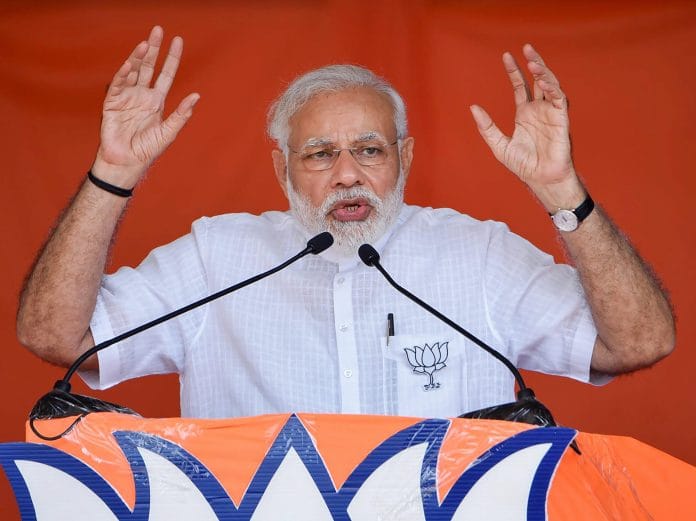The Supreme Court now has 24 judges while its sanctioned strength is 31. In 2014, when the Modi government came to power, the SC had 28 judges.
New Delhi: Union law minister Ravi Shankar Prasad has said a record number of judicial appointments have been made during the tenure of the Narendra Modi government so far, seeking to counter allegations of its slow approach to the issue as he listed the administration’s achievements.
“In 2016, the highest-ever appointments of high court judges were made,” he said.
But while data shows that the number of appointments has indeed increased after 2014, the number of vacancies in high courts has also risen every year since.
Apart from this, Prasad made a slew of assertions on the ministry’s performance. But many of the assertions, when placed in context, do not convey a success story. ThePrint analyses the significant ‘achievements’.
Judicial appointments
Judicial appointments have been a hot button for the Modi government. The recent stalling of Uttarakhand High Court chief justice K.M. Joseph’s elevation to the Supreme Court has created the perception that the rift between the government and the judiciary has hit its lowest point since the Emergency.
Perception aside, even numbers do not portray judicial appointments as a success story for the Modi government.
In 2015, three Supreme Court judges, including the then CJI H.L. Dattu, retired but no fresh appointments were made since the court had stayed — and then struck down — National Judicial Appointments Act.
In 2016, six judges retired but only four were appointed. In 2017, four retired and five were appointed. In 2018, seven vacancies will arise but only one appointment, Justice Indu Malhotra, has been made so far.
Overall, the apex court now has just 24 judges while its sanctioned strength is 31. In 2014, when the Modi government came to power, the SC had 28 judges.
Even in high courts, as mentioned before, the rise in the number of appointments has been in sync with the increasing number of retirements every year. As a result, the net difference has been widening.
In 2015, a year after the Modi government assumed office, India’s 24 high courts were 384 judges short of their sanctioned strength of 1,017. From 38 per cent in 2015, the share of vacancies rose to 45 per cent in 2016. It dipped to 39.6 per cent in 2017 as the government appointed 117 judges.
Prasad has claimed that, in 2016, 126 judges were appointed, setting a record for maximum appointments in a single year. But in the previous years, 2014 and 2015, no appointments were made due to the standoff over the National Judicial Appointments Commission (NJAC).
Envisaged as a body that would reduce the “opacity” in judicial appointments made by the collegium, the NJAC was struck down by the Supreme Court that deemed it a challenge to judicial independence.
“Appointments were practically stalled in 2014 and 2015. So the record high in 2016, as the government claims, was a bid to catch up. The vacancies had soared to almost 50 per cent and functioning of courts was being affected,” said B.S. Suryaprakash, a fellow and programme director at Daksh, a Bengaluru-based research organisation that focuses on the judiciary.
Rationalisation of tribunals
Prasad also sought to highlight the Modi government’s decision to limit the number of tribunals, or quasi-judicial fora. Out of the 31 tribunals four years ago, he said, only 18 remained.
While the move has streamlined the functioning of these courts, it has also left them understaffedand overburdened. For example, the National Company Law Tribunal has just 26 judges on 10 different benches. Of the cases pending before the tribunal, 2,500 pertain to insolvency alone, according to official data.
The National Company Law Appellate Tribunal, which hears appeals on insolvency cases, company law disputes and competition law cases has just six judges on three different benches. In many cases, when a three-judge bench is required, the court is left with just two benches.
The National Green Tribunal, tasked with quick disposal of matters pertaining to the environment, has been functioning at half its sanctioned strength of 182 — and with an acting chief — for more than six months now.
Triple talaq
Prasad also made a pitch to opposition parties to support the proposed law criminalising instant triple talaq, the controversial Islamic practice allowing men to divorce their wives by saying the word thrice in quick succession. The practice, illegal in several Islamic nations as well, was ruled unconstitutional last year by the Supreme Court, and it was in the wake of this verdict that the government drafted a law to bar it for good.
In December last year, the bill raced through the Lok Sabha, but it was stalled in the Rajya Sabha by a united opposition, which has taken issue with the provision criminalising the practice.
Since then, although the BJP’s numbers have improved in the upper house, the bill has not been reintroduced. The government briefly considered bringing an ordinance but has not done it so far.






